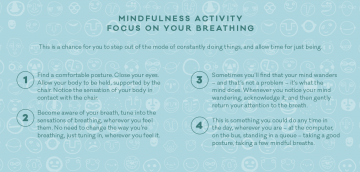Note: you are receiving weekly MoodFx Tips because you subscribed through your MoodFx account. To unsubscribe to these Tips and other MoodFx Alerts, such as Mood Check and Appointment reminders, simply sign in to your MoodFx account at www.MoodFx.ca and go to the Alerts page. There, you can select whether you wish to subscribe or unsubscribe to any and all email and text Alerts. If you are having difficulty, please email info@MoodFx.ca for assistance.
Track your side-effects to medications with MoodFx
Did you know you can use MoodFx to monitor side-effects to medication(s) for depression and anxiety? Side-effects can be an important factor to consider when you and your doctor make decisions about treatment.

MoodFx uses the Frequency, Intensity, and Burden of Side-Effects Rating Scale (FIBSER for short), a very brief (3 questions), validated scale that’s been shown to be useful in clinical decision-making.
Now, when you do a Mood Check for the first time, you will be asked whether you take medications for anxiety/depression and if so, whether you would like to monitor side-effects to these medications. You can also update this information when you do a subsequent Mood Check.
How much your side-effects cause problems for you will also appear in your Results and History chart:

Note that you can also turn side-effects tracking on or off at any time, under your Profile page.
Tips for resilience and mental fitness
Feeling optimistic, calm, and content can help you to cope with life stressors. This week, we share some tips from the Canadian Mental Health Association that can help you to boost your mental well-being.

Photo credit: Micah Hallahan
The Canadian Mental Health Association is a nation-wide voluntary organization that promotes mental health for all, and supports the resilience and recovery of people experiencing mental illness.

Strategies for dealing with stress
This week, check out these tips for coping with stress, from Here to Help‘s Stress & Wellness Module, with specific examples on how to:
- Focus on what you can do
- Manage your emotions
- Seek out support
- Focus on the positives
- Make a plan of action
- Self-care
- Take care of your relationships
- Spirituality
- Acceptance
- Distraction
Work through the Stress and Wellness module here.

Setting Healthy Boundaries
Having boundaries means prioritizing your needs, whether that’s in self-care, career aspirations, or within relationships. Boundaries can be hard and well-defined limits, but they can also be flexible. Because of its effects on self-esteem and thoughts, depression can sometimes interfere with our ability to recognize and assert our boundaries.
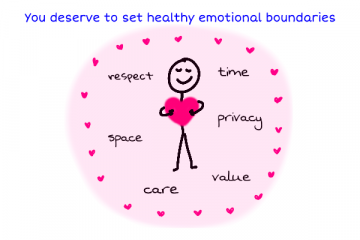
This week, check out this guide provided by Heathline to learn more about the nuts and bolts of boundaries, how to recognize red flags, determine your boundaries, as well as find tips on how to honour other people’s boundaries.
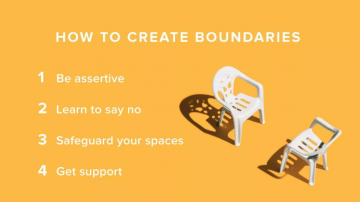
Take a few moments to be mindful, or learn more in-depth mindfulness skills with an online course
You may have heard about mindfulness as an evidence-based practice that can help you deal with depression, anxiety, and everyday stress. But what is mindfulness, and is it something that might work for you?
Mindfulness is an approach to our thoughts, emotions, physical experiences, and life in general that involves paying close attention to how we feel, without judging those feelings. By promoting self-awareness and self-compassion, mindfulness can in turn increase our ability to manage difficult situations and make wise choices.
Mindfulness is a skill that needs to be learned and practiced like any other. If you want to learn more about incorporating mindfulness into your wellness skill set, check out these online resources:
http://www.freemindfulness.org/ – a website compiling free mindfulness meditation exercises for download, mindfulness apps, and other resources
9-great-mindfulness-courses-you-can-take-online – a compilation of mindfulness courses, both paid and free, from around the web
www.BeMindfulOnline.com – an online mindfulness course (cost: $40 USD in the United States and Canada) developed by researchers at Oxford University and the UK’s Mental Health Foundation

Make yourself a cup of tea or grab a glass of water and take a few moments to focus on a few deep breaths–something mindful you can do right away.
Join the MoodGYM!
Have you visited the MoodGYM yet?
Developed by the National Institute for Mental Health Research of Australia, the MoodGYM is an interactive training program that teaches you Cognitive Behavioural Therapy (CBT) skills for coping with and preventing depression, at your own pace.
Using illustrations and online exercises, MoodGYM will guide you through 5 modules, plus an interactive game, anxiety and depression assessments, downloadable relaxation audio, a workbook, and feedback assessment.
MoodGYM was previously offered for many years free-of-charge; however, to ensure sustainability of the program, it now costs $39(AUD) for 12 month’s access.
Antidepressant Skills Workbook
The Antidepressant Skills Workbook (ASW) is an excellent, free online resource that helps you learn more about depression and how to manage it, according to the best available research. It also provides a step-by-step guide to changing the thought and behaviour patterns that can trigger and/or sustain depression.
Developed by the Centre for Applied Research in Mental Health and Addiction (CARMHA) based at Simon Fraser University in British Columbia (BC) and BC Mental Health & Addiction Services (BCMHAS), the Workbook can be accessed in your browser to work through or print, download, and listen to in audio (MP3) form.
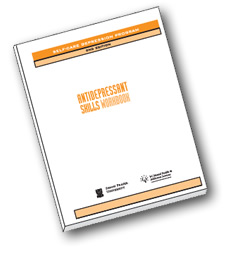 Check it out here.
Check it out here.
What Helps, What Hurts: Helping loved ones know how to support you best
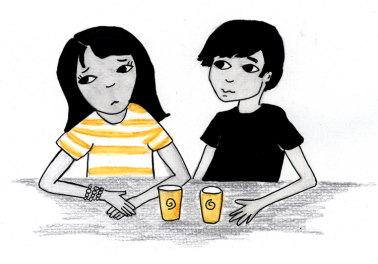
Image credit: What Helps, What Hurts; Mood Disorders Association of BC
Do you have loved ones who want to learn more about how to be supportive of you, or anyone who is dealing with depression or low mood? Try sharing this resource, developed by the Mood Disorders Association of BC and Here to Help: What Helps, What Hurts.
You can also download and share the PDF of their four-step guide or read it online here.


Active coping – a prerequisite self-management strategy for depression
Last month, we featured several self-management tips contributed by people with lived experience of depression. These strategies were compiled as part of a study aimed at better understanding the kinds of self-management strategies that real people with depression find helpful for managing depression in their everyday lives.
To recap, participants generated nearly 100 unique self-management strategies, which the researchers were then able to categorize into 6 broad domains:
- Awareness that depression needs active coping
- Active coping with professional treatment
- Active self-care activities, structure, & planning
- Free time activities
- Social engagement
- Work-related activities

Photo credit: Thorn Yang, stocksnap.io
This week, we focus in on the strategies included in the first two domains, Awareness that depression needs active coping, and Active coping with professional treatment. These strategies are presented in order of how helpful participants perceived them to be, with starred strategies being the most likely to be helpful.
Awareness that depression needs active coping
What is “active coping?” Active coping entails being aware of a stressor—in this case, the various symptoms of depression and depression itself—and taking steps to reduce the negative effects or outcomes of that stressor. Those of you who are reading this week’s tip are probably already well aware that actively coping with your depression, anxiety, and other mental health stressors is an important part of getting better, maintaining your well-being, and improving your quality of life. After all, that’s why you’re here! MoodFx tips aim to suggest a variety of active coping strategies that you can try out and adopt when they prove helpful for you.
The following are the overarching strategies participants identified relating to this theme.
- Take the signals of my depression seriously**
- Acknowledge that depression is a disease**
- Start to make more and more decisions myself again
- Engage in a structured form of meditation (e.g. yoga, mindfulness)
- Do my best not to avoid issues
- Take my medication at a fixed place and/or time

Photo Credit: Paola Chaaya, stocksnap.io
Active coping, with professional treatment
Several participants brought up active coping strategies that involve working with a qualified health professional. One particularly important aspect of this was finding a professional with whom they had a good working relationship.
- Maintain long-term professional support**
- Find a doctor/therapist with whom I feel a connection**
- Find the type of treatment that suits me best
- Take warnings from others about increasing symptoms of my depression seriously, even if I do not notice it myself
- Make sure I have telephone support when needed from family/friends/an organization
- Find further information about my depression as needed
- Make sure I have professional support when using my medication
- Ask my doctor/therapist for explanations about my medication

Photo credit: Josh Wilburne, stocksnap.io
In upcoming weeks, we will review the final two self-management strategy categories, so stay tuned! In the meantime, you can read the abstract and access the original article at the link below:
Active self-care activities, structure, & planning

Photo credit: Luis Llerena
Collaborating with people with depression, researchers from the University of Amsterdam recently conducted a novel study to learn about the self-help strategies people use to cope with symptoms of depression, and which strategies people found to be the most helpful. We will expand on the results of this important study in the upcoming weeks, so stay tuned!
The researchers asked 25 people with depression to share their self-management strategies and rate them according to how helpful they thought they were. Participants generated nearly 100 unique strategies, which the researchers then grouped into 6 broad strategy categories:
- Being aware that depression needs active coping
- Active coping with professional treatment
- Active self-care activities, structure, & planning
- Free time activities
- Social engagement
- Work-related activities
This week, we share the pragmatic strategies from category 3: Active self-care activities, structure, & planning. Some of these have also been featured in previous MoodFx tips.
Active self-care activities, structure, & planning for depression:
- Get enough rest to avoid exhaustion through over-exertion
- Don’t be afraid to give yourself the time for rest you need.
- Be realistic about the responsibilities you can take on at the moment; it’s okay to say “no” when your plate is full.
- Set realistic, short-term goals
- Rather than aiming for overwhelming, unspecific goals like “clean my place this weekend,” break large tasks into more manageable, realistic ones.
- Schedule the smaller aspects of a task so that you have a concrete time frame for getting it done, one step at a time.
- Make your goals SMART: Specific, Measurable, Attainable, Realistic, Time-bound, & Evaluated
- Establish a proper day/night rhythm
- Go to bed around the same time each night and wake up at the same time each morning, even on weekends/your days off.
- Avoid bright artificial light after sunset, especially on electronic devices like computer screens.
- Ignore the tiredness associated with depression.
- Despite your best efforts to stay well-rested, it’s not uncommon to still feel fatigued when you are dealing with depression. Some people in this study found it helpful to push themselves to do the activities they would normally or had planned to do despite this fatigue. You might even feel your energy return once you start something; this can be especially true with exercise.
- Get dressed every day.
- Although staying in pajamas can be tempting, make an effort to get dressed and ready to go outside.
- Engage consciously in relaxing activities.
- Make an adjusted activity schedule.
- Keep a diary.
- Writing down your thoughts and feelings can help make them more concrete and less overwhelming. It can also help you to see your thoughts in a more objective manner.
- Take a shower every morning.
- Similar to getting dressed every day, participants likely found this strategy helpful as it is part of a personal care routine that prepared them to accomplish their other daily activities.
- A morning shower can also help you to wake up and can be an enjoyable and relaxing physical experience.
- Eat healthfully.
- Make sure you will be awakened every morning.
- Set an alarm clock, even on your days off, to make sure you wake up at a reasonable time. This also helps to maintain a proper sleep/wake cycle.
- Make plans for the future.
- Plan something you can look forward to, be it a night out with your partner, a concert or theatre show, a day’s excursion to someplace new, or a personal indulgence like a long, hot bath or time to read a good book.
- For bigger plans and longer-term goals, remember to make them Specific, Measurable, Attainable, Realistic, and Time-bound.
- Take every opportunity to tidy the house.
- Even if it’s just a small task, like doing the day’s dishes or putting away your clothes, doing a little bit each night or whenever you have a few moments to spare will help prevent clutter from accumulating—which can easily feel overwhelming.
You can read the abstract and access the original article by following the link below:
Mental Health M.A.P. (My Action Plan) – Excellent online resource and step-by-step guide to working through common mental health issues

If you haven’t already, check out the Mood Disorders Association of Ontario‘s excellent online resource for working through common mental health struggles such as depression, anxiety, and bipolar depression. Mental Health: My Action Plan (Mental Health M.A.P) is “is all about you and what you can do to have the best possible mental health,” helping you to plan and enact your own journey to recovery and wellness. Its features include:
- 11 step-by-step lessons to help you create a personalized plan for recovery and wellness, from starting your journey and getting help to maintaining your preferred healthy lifestyle and staying well once you feel better
- the ability to share your personalized plan with the people supporting you in your journey
- a large collection of resources that include personal stories of mental health difficulties and recovery success, expert insights, and other contributions from people with lived experience of mental illness
You might find this an excellent addition to your toolkit of free, self-led interactive programs for mental wellness. Others we’ve featured through MoodFx have included Working Through It, Walkalong (with a focus on youth and young adults), and MindShift from AnxietyBC. If you have other online resources you’ve found helpful, feel free to send them to info@moodfx.ca so we can share them with the rest of our users.
The Importance of Sleep: Getting a better night’s rest

Photo credit: Krista Mangulsone, stocksnap.io
Changes in sleep are a common symptom of mood disorders and anxiety, ranging from oversleeping, to insomnia, or both.
This week, check out these doctor-recommended strategies you can try to improve the amount and quality of your sleep. Often called “sleep hygiene,” these are specific behaviours that can promote a better night’s rest.
- Allow enough time for 7 to 9 hours of sleep each night, the normal range needed for healthy adults. Everyone’s different: some people function well with only 7 hours, whereas others need at least 9 hours of sleep to feel refreshed. If you need to, schedule your sleeping hours in your calendar the way you would any other commitment and stick to it. Sleep is a wise investment and should be a priority.
- Maintain a regular sleep schedule. This means going to bed and waking up at around the same time each day, including weekends. Over time, your body will adapt to your schedule, making it easier to both fall asleep and wake up.
- Limit your time in front of bright screens late at night, including computers, tablets, and phones, to help you wind down and sleep better. Read traditional paper books, eReaders, or use nighttime settings on other electronics.
- Maintain a sleep environment that is dark, comfortable, cool, and quiet. Try using blackout curtains or an eye shade and earplugs if your room is too bright or noisy. Turn down the heat and open a window for some fresh air while you sleep.
- Avoid heavy meals and alcohol and reduce your intake of caffeine (e.g., in tea, coffee, or soda) and other stimulants several hours before bedtime. You might set new limits on your caffeine consumption, for example, having only one cup of coffee in the morning and no caffeine after 1pm.
- Aim for 20 to 30 minutes of cardio exercise five to six hours before your usual bedtime, but make sure to avoid exercise immediately before bed. Regular cardio exercise offers a multitude of benefits; 4-5 times per week for at least 30 minutes has also been shown to boost mood.
- In the winter, try waking up with a dawn simulator or light alarm clock. Many retailers now carry a variety of brands that gradually wake users with increasing light and sound. You can also check out this article by Dr. Lam in the Globe and Mail on dawn simulator alarm clocks and seasonal depression.
- Try a few relaxation exercises just before bed, such as deep breathing, stretches, or easy yoga.
- Avoid working on or dealing with tasks and problems that cause stress or distress soon before bed. Try tackling these the next morning, when you will have more energy to think clearly and enact solutions.
If you continue to have significant trouble sleeping, talk to your family doctor; specific sleep difficulties or disorders may require particular treatments.
Find time for pleasurable activities each day

Photo credit: Olu Eletu, stocksnap.io
With a busy schedule and many obligations, it can be difficult to find the time to do something just for your own enjoyment. When you are dealing with low mood and depression, it’s also not uncommon to lack the motivation or interest to do the fun or pleasurable activities you used to enjoy. However, engaging in regular pleasurable activities can help you feel better. It’s important to do fun, restorative activities when you can, even if you don’t feel like it—in time, your enjoyment will return.
For inspiration, it can help to build a list of activities you would normally enjoy that you can consult when you are feeling down. Include a variety of activities you can do in different settings and circumstances, including short breaks if you don’t have a lot of time, and activities you can do on your own.
Some examples might be:
- Phone a friend or talk to a family member face-to-face
- Listen to music
- Go for a short walk around your neighborhood
- Spend some time in nature, such as a local park
- Read a good book
- Watch a funny or engaging movie or TV show
- Take a long, hot bath or shower
- Spend some time playing with a pet
- Cook your favorite meal for dinner
- Visit a local landmark or attraction
This tip has been adapted from www.helpguide.org, a non-profit resource for people dealing with mental and other health issues.
Help others understand what it’s like to live with depression with this interactive online game
Help your loved ones understand more about clinical depression with an interactive online game that simulates what it’s like to manage everyday life when the illness takes hold. Or, play for yourself to remember that you are not alone, and that many others have experienced depression, too.

Screencaps of an encounter in Depression Quest
Developed by Zoe Quinn, Patrick Lindsey, and Isaac Shankler, Depression Quest is
an interactive fiction game where you play as someone living with depression. You are given a series of everyday life events and have to attempt to manage your illness, relationships, job, and possible treatment. This game aims to show other sufferers of depression that they are not alone in their feelings, and to illustrate to people who may not understand the illness the depths of what it can do to people.
Support from family and friends is an important part of managing depression, and understanding more about the condition can help your loved ones better support you. This true-to-life, interactive game is a unique and powerful medium through which to share the experience.
10 Tips for Reaching Out and Building Relationships

Close, caring relationships can help us fight off depression. Photo by Krista Mangulsone, stocksnap.io
Close, caring relationships and social connection are essential human needs that can also be powerful in preventing and alleviating depression and anxiety. While depression can cause even the most social among us to lose interest in spending time with friends and loved ones, it’s important to push yourself to maintain and cultivate these relationships.
The following tips for staying connected are provided from HelpGuide.org, a free not-for-profit initiative to help people from all walks of life improve their health and well-being.
- Talk to one person about your feelings
- Help someone else by volunteering
- Have lunch or coffee with a friend
- Ask a loved one to check in with you regularly
- Accompany someone to the movies, a concert, or a small get-together
- Call or email an old friend
- Go for a walk with a workout buddy
- Schedule a weekly dinner date
- Meet new people by taking a class or joining a club
- Confide in a clergy member, teacher, or sports coach
To read more helpful strategies for managing depression and low mood, visit the HelpGuide website here.
Make a list of fun winter activities

Photo by Galina N on Unsplash
With their colder days and darker nights, the fall and winter months can be an especially difficult time to stay active and social–and as the seasons change, so too must the activities we do for fun.
That’s why this week, try making a list of both some solo and social activities (aim for 3-5 of each) you would like to try or do regularly this winter. Winter can be a great time of year to devote some time to a new hobby, skill, or activity you’ve been meaning to try. For example, you might want to sign up for a community pottery class, join an amateur evening sports team, get into photography, or invite a few friends for a potluck dinner each month.
Once you’ve made your list of activities, pick one and take one concrete step to make it happen. For example, you might research some local classes online, or send out invites to a few friends for a dinner.
If you need more fun winter activity ideas, find other ideas on the web, e.g., at home.

Photo by Amir Hamdi on Unsplash
Consider speaking to your doctor about light therapy

Light therapy devices emit full-spectrum white light, mimicking the sun’s rays.
Light therapy has long been known to be an effective treatment for winter depression, also known as Seasonal Affective Disorder, or SAD. Research conducted and published by Dr. Raymond Lam and colleagues at the University of British Columbia has now provided strong evidence that light therapy can also be an effective treatment for non-seasonal clinical depression. In a randomized controlled trial, patients who used a light therapy device either alone or in combination with a standard antidepressant (fluoxetine) had greater improvements in their symptoms than those who used the antidepressant alone, or a placebo.
Light therapy is usually well-tolerated and can be used with other treatments for depression, such as psychotherapy and medications.
Consider speaking to your doctor about whether light therapy might be a good option for you.
Note: It is important to always consult with a doctor before starting any kind of light therapy, as it may not be safe or appropriate for everyone.
To read more about the study, check out the press release here.
To learn more about Seasonal Affective Disorder (SAD) and light therapy, visit our website: www.ubcsad.ca
New!: Have more control over your MoodFx account
Did you know you can turn your MoodFx alerts (text and email messages) on or off at any time with your account? Simply sign in and go to your Alerts page. We’ve now added a one-click button to unsubscribe to all Alerts.
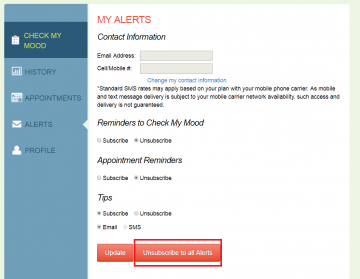
For users who decide they want to deactivate their account entirely, you can now do so yourself, under your Profile page. Please note that account deactivation cannot be undone. Once you deactivate your account, you will no longer be able to sign in or recover your previous data.
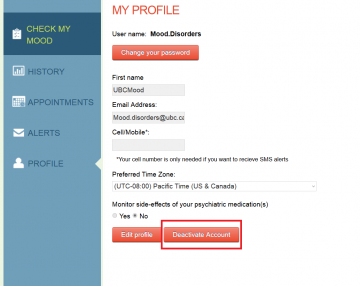
Our Terms of Use and Privacy Policy haven’t changed. If you have any questions about these updates or MoodFx in general, as always, please send us an email, at info@moodfx.ca.
New!: Help your health care provider(s) use MoodFx by sharing our orientation letter for practitioners

Doctor and Patient Conferring About Results on On Digital Tablet
You can now download and share a brief letter specifically written for health care provider(s) to explain more about MoodFx and how to use it with you. This can be helpful for clinicians who are not yet familiar with the program.
Download the letter anytime on your MoodFx Results page, or access it here.
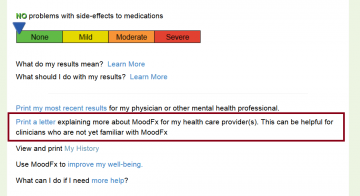
Note: You receive tips by email or SMS because you have subscribed to MoodFx Tips. To unsubscribe, please sign in at www.MoodFx.ca and select “Unsubscribe” under “Tips” on your Alerts page.

